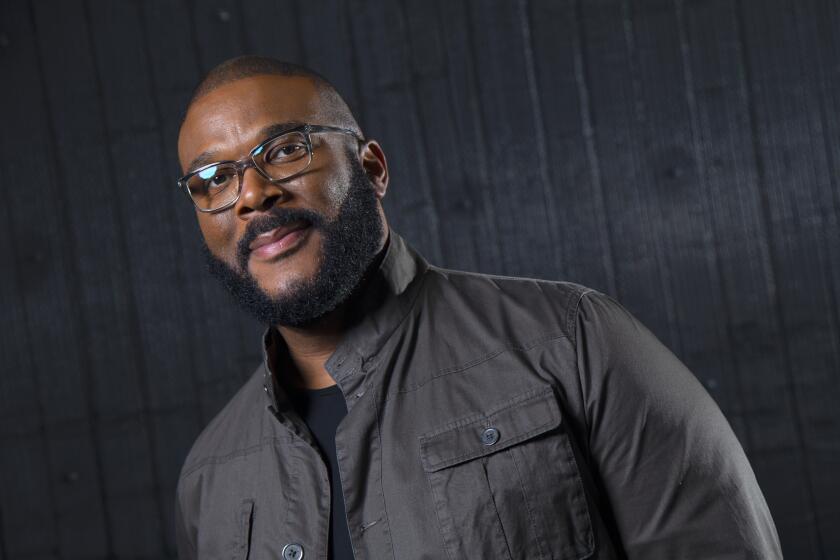ART / Cathy Curtis : Bank’s Handsome New Gallery Compounds Interest in Inaugural Show
- Share via
Orange County just received a wonderful present. It’s spacious, well-designed and--in its inaugural show--filled with exciting, first-rate art. It’s convenient to the freeways, has ample parking, charges no admission and is open six days a week.
The name of this place--which opens Tuesday--is Security Pacific Gallery. It’s in the South Coast Metro Center, at 555 E. Anton Blvd. in Costa Mesa. And it looks like the best thing that has happened to visual arts in the county since Newport Harbor Art Museum announced its expansion.
Situated on the ground floor of the new regional headquarters of Security Pacific Bank, the gallery is, of course, partly a shrewd means of spreading corporate good will. But the bank’s commitment to art is genuine. Its collection of 9,000 works (paintings, sculptures, works on paper--including photographs--and textiles, mainly by American artists) was initiated in the early 1970s. For the past 13 years the bank has had changing exhibitions at Gallery at the Plaza on the ground floor of its corporate headquarters in downtown Los Angeles.
The new space, designed by Frederick Fisher, is spiffier than the one in Los Angeles. Rather than looking like an extension of the lobby, the gallery occupies a separate, walled-off portion of the ground floor. The floors are bare concrete (the stylish look these days), the white walls are punctuated by long, angular windows and the ceilings are as high as 14 feet.
Three artists have added detailing that lends warmth and personality to the space without overwhelming the art. Jud Fine spells out “WHY SePac ART” in Morse code on the columns supporting the ceiling, translating the dots and dashes into wide and thin bands of copper, snakeskin, gold leaf and other materials. Lita Albuquerque’s creations are three copper-ceiling lighting fixtures with neon tubing creating soft-blue auras.
Eric Orr is responsible for several items, including floor inlays of wood circles and granite strips (reminiscent of the geometrical look of Russian Suprematist art) and the rising-smoke effect sandblasted into the glass entryway. It is lit from underneath to enhance the misty illusion.
The current show, “Art in the Public Eye: Selected Developments” (on view through Aug. 19) consists of work by 14 significant American--mostly California-based--contemporary artists of vastly differing sensibilities. The paintings, photographs, sculptures and mixed-media pieces come from Security Pacific’s holdings as well as museums, galleries and private collections.
With three to six pieces by each artist, the show gives the viewer a basic notion of the various kinds of imagery that have preoccupied a particular artist over time, or the ways an artist has investigated a particular theme in several works.
Now in her early 80s, painter Helen Lundeberg is the senior artist of the group. The abstract qualities of architecture--of walls, arches and doorways and the views they permit of the outside world--have been her major concern for the past several decades.
In “Mirror and Pink Shell” from 1952, a chair positioned in a room with broad, sharply defined fields of muted color holds a tall mirror, a shell and a curled leaf. These enigmatic, talisman-like still-life objects vanish in her later work, leaving the stark interplay of planes of color.
Slices of cold white wall in “Arches IV” (1962) clamp down against the browns and deep red of distant arches. In “Cobalt Sky” (1973), Lundeberg transforms a sunstruck column into a flat white strip inflected with sharp accordion folds. And “Grey Interior” (1979) is a particularly elegant geometrical two-step in which tall and diminutive doorways lock together in a monochromatic void.
In the early 1960s, Edward Ruscha (pronounced roo-shay )--then in his mid-20s--began showing the world how his mind works. The audacious rightness of its combinations of images and words and ideas have been dazzling viewers ever since.
In an untitled painting from 1986, an American flag is superimposed on a black background crisscrossed with a grid of tiny blurred lights, like the view from an airplane making a night landing. Painted before George Bush’s campaign references to the “1,000 points of light,” the image brings to mind clogged freeways, wasteful electricity consumption, stultifying conformity (the grid stretches out inexorably in all directions)--and the comfort and relief we nonetheless feel whenever we fly back home.
The most arresting Ruscha work is “17th-Century,” a vast horizontal swag of dark clouds suspended over a black ocean with the silhouette of a tiny sailing ship at the horizon. On the sky, in gothic lettering are the words: “War! Alchemy! Taxes! Plague! Damsels! Firewood! Melancholia!” In other words, the problems of the world 300 years ago are distressingly similar to the ones we have today.
There isn’t space here to roam through the other well-chosen groupings of work by such worthy artists as Alexis Smith, Jackie Ferrara, Frank Stella, Robert Therrien, Peter Shelton, John Divola and Charles Garabedian. That will come later, along with a discussion of the gallery’s “project room.” Designed to house long-term installations, it is being transformed by Jim Turrell, who performs small miracles with the intangible media of light and space. His two walk-in pieces, “Night Light” and “Alien Exam,” will remain on view through Dec. 17.
“Art in the Public Eye: Selected Developments” is on view through Aug. 19 at the new Security Pacific Gallery, South Coast Metro Center, 555 E. Anton Blvd. in Costa Mesa. Hours: 11 a.m. - 5 p.m. Tuesday through Sunday. Admission free. Information: (714) 433-6000.
More to Read
The biggest entertainment stories
Get our big stories about Hollywood, film, television, music, arts, culture and more right in your inbox as soon as they publish.
You may occasionally receive promotional content from the Los Angeles Times.










